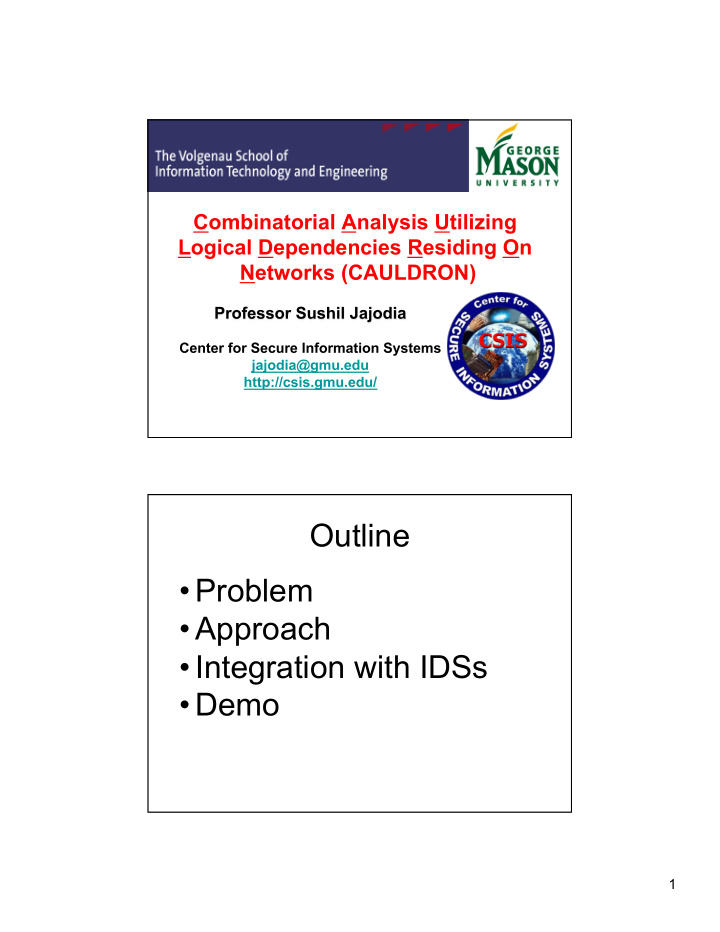



Combinatorial Analysis Utilizing Logical Dependencies Residing On Networks (CAULDRON) Outline • Problem • Approach • Integration with IDSs • Demo 1
Attack 160 158 47 Target Vulns Vulns Vulns 107 Vulns Vulnerability Scanner 60 Vulns External Attacker Vulnerability Scanner 41 Vulns 15 Vulns 3 Limitations of Vulnerability Scanners • Generate overwhelming amount of data • Example Nessus scan – Elapsed time: 00:48:07 – Total security holes found: 255 – High severity: 40 – Low severity: 117 – Informational: 98 • No indication of how vulnerabilities can be combined • Can an outside attacker obtain access to the Crown Jewels? • Where does a security administrator start? 2
Limitations of IDSs • Generate overwhelming number of alerts • Many false alerts – normal traffic or failed attacks • Alerts are isolated • No indication of how alerts can be combined • Incomplete alert information • Where does a security administrator start? • Is the attacker trying to obtain access to Crown Jewels? • Require extensive human intervention Summary • Current security measures largely independent • Little synergy among tools • Vulnerabilities considered in isolation may seem acceptable risks, but attackers can combine them to produce devastating results 3
What is lacking? • Context for total network security • How outsiders penetrate firewalls and launch attacks from compromised hosts • Insider attacks The reality – security concerns are highly interdependent. Simply Listing Problems 8 Misses the Big Picture! 4
Penetration Testing • Few experts available • Red teams can be expensive • Tedious • Error-prone • Impractical for large networks • No formal claims Attack Graphs • An attacker breaks into a network through a chain of exploits where each exploit lays the groundwork for subsequent exploits • Chain is called an attack path • Set of all possible attack paths form an attack graph • Generate attack graphs to mission critical resources • Report only those vulnerabilities associated with the attack graphs 5
Linux attack tools Attacker 10.10.101.10 NT4.0 Firewall Linux IIS wu_ftpd Hub Web Server Mail Server 10.10.100.20 10.10.100.10 6
7
8
Reference • Sushil Jajodia, Steve Noel, Brian O’Berry, “Topological analysis of network attack vulnerability,” in Managing Cyber Threats: Issues, Approaches and Challenges , Vipin Kumar, Jaideep Srivastava, and Aleksandar Lazarevic, eds., Springer, 2005, pages 248-266. Minimal-Cost Network Hardening 9
Solution 1 Solution 1 Solution 1 Solution 1 Solution 1 Solution 1 Solution 2 Solution 2 Solution 2 Solution 2 10
No impact No impact Reference • Lingyu Wang, Steven Noel, Sushil Jajodia, "Minimum-cost network hardening using attack graphs," Computer Communications , 2006. 11
Attack Graph Visualization Problem Even small networks can yield complex attack graphs! 23 Attack Target External Attacker 24 12
25 26 13
27 Limitations of IDSs • Generate overwhelming number of alerts • Many false alerts – normal traffic or failed attacks • Alerts are isolated • No indication of how alerts can be combined • Incomplete alert information • Where does a security administrator start? • Is the attacker trying to obtain access to Crown Jewels? • Require extensive human intervention 14
Alert Correlation • Correlate alerts to build attack scenarios • For efficient response, this must be done in real time Attack Graph Approach • Provides context for alarms • Can help with forensic analysis, attack response, attack prediction 15
Hypothesizing and Predicting Alerts • Correlation based on the prepare-for relationship is vulnerable to alerts missed by IDSs - Reassembling a broken attack scenario is expensive and error-prone • By reasoning about the inconsistency between the knowledge (encoded in attack graph) and the facts (represented by received alerts), missing alerts can be hypothesized • By extending the facts in a way that is consistent with the knowledge, possible consequences of current attacks can be predicted Protect What-If Detect Network 32 16
Security Metrics Network Hardening CAULDRON has Numerous Applications Alarm Sensor Correlation Placement And Attack Response 33 CAULDRON Has Wide Customer Base DHS NSA FAA AFOSR NRO AFRL JIOC DISA 34 17
FAA CSIRC Deployment, Leesburg, VA FAA CSIRC Deployment, Leesburg, VA FAA Headquarters 35 Summary of CAULDRON • Automated analysis of all possible attack paths through a network – Resulting attack “roadmap” provides context for optimal defenses – Transforms volumes of isolated facts into manageable, actionable results • Integrates with existing tools for capturing network configuration • Your network is provably secure, with minimum effort • Best tool for making informed decisions about network security 36 18
Further Information: Sushil Jajodia jajodia@gmu.edu (703) 993-1653 http://csis.gmu.edu/ 19
Recommend
More recommend